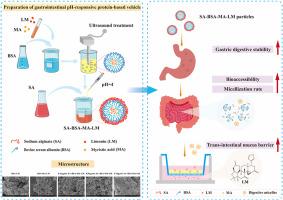The fabrication of gastrointestinal pH-responsive sodium alginate surface-modified protein vehicles to improve limonin digestive stability, bioaccessibility and trans-intestinal mucus barrier capacity
IF 11
1区 农林科学
Q1 CHEMISTRY, APPLIED
引用次数: 0
Abstract
Protein-based delivery systems tend to degrade too quickly in the gastrointestinal tract. Applying polysaccharide-based surface coatings on protein carriers is an effective strategy to prevent interference from gastric acid and proteases during the digestive process. This study prepared gastrointestinal pH-responsive bovine serum albumin (BSA)-myristic acid (MA) carriers using sodium alginate (SA)-based surface coating technology to improve the digestive properties and intestinal mucus penetration of limonin (LM). The results showed that ultrasonication caused uniform hydrophilic BSA and MA particle formation in optimal conditions. Fourier-transform infrared spectroscopy (FTIR) and scanning electron microscopy (SEM) observations confirmed that SA adhered to the BSA-MA particle surfaces via electrostatic interaction at pH 4, causing the controlled gastrointestinal release of the self-assembled BSA-MA complexes. The subsequent SA-BSA-MA complexes displayed an LM encapsulation yield (EY) of >84%. In vitro, simulated gastrointestinal digestion indicated that compared with free LM, the SA-BSA-MA particles significantly increased the intestinal LM retention rate, bioaccessibility, and micellization rate by 45.49%, 155.48%, and 102.14%, respectively. The results of the artificial intestinal mucus experiments demonstrated that the trans-intestinal mucus barrier capacity of SA-BSA-MA particle-loaded LM was significantly enhanced. Its apparent permeability coefficient (Papp) (6.53 × 10−6 cm/s for free LM) and intestinal mucus permeability (17.56% for free LM) increased substantially to 14.22 × 10−6 cm/s and 38.22%. This study presents a gastrointestinal pH-responsive delivery system that effectively improves the ability of hydrophobic nutrients to cross the intestinal mucus barrier.

制造胃肠道 pH 响应型海藻酸钠表面修饰蛋白质载体,提高柠檬素的消化稳定性、生物可及性和跨肠道粘液屏障能力
以蛋白质为基础的给药系统在胃肠道中往往降解过快。在蛋白质载体上涂覆多糖类表面涂层是防止消化过程中胃酸和蛋白酶干扰的有效策略。本研究利用基于海藻酸钠(SA)的表面涂层技术制备了胃肠道pH响应型牛血清白蛋白(BSA)-肉豆蔻酸(MA)载体,以改善柠檬素(LM)的消化特性和肠粘液渗透性。结果表明,在最佳条件下,超声处理可使 BSA 和 MA 颗粒形成均匀的亲水性。傅立叶变换红外光谱(FTIR)和扫描电子显微镜(SEM)观察证实,在pH值为4的条件下,SA通过静电作用附着在BSA-MA颗粒表面,导致自组装的BSA-MA复合物在胃肠道内可控释放。随后的 SA-BSA-MA 复合物显示出 84% 的 LM 包封率(EY)。体外模拟胃肠道消化表明,与游离 LM 相比,SA-BSA-MA 颗粒显著提高了肠道 LM 保留率、生物可及性和胶化率,分别提高了 45.49%、155.48% 和 102.14%。人工肠粘液实验结果表明,SA-BSA-MA 颗粒负载的 LM 经肠粘液屏障能力明显增强。其表观渗透系数(Papp)(游离 LM 为 6.53 × 10-6 cm/s)和肠粘液渗透率(游离 LM 为 17.56%)分别大幅提高到 14.22 × 10-6 cm/s 和 38.22%。这项研究提出了一种胃肠道 pH 响应输送系统,它能有效提高疏水性营养物质穿过肠粘液屏障的能力。
本文章由计算机程序翻译,如有差异,请以英文原文为准。
求助全文
约1分钟内获得全文
求助全文
来源期刊

Food Hydrocolloids
工程技术-食品科技
CiteScore
19.90
自引率
14.00%
发文量
871
审稿时长
37 days
期刊介绍:
Food Hydrocolloids publishes original and innovative research focused on the characterization, functional properties, and applications of hydrocolloid materials used in food products. These hydrocolloids, defined as polysaccharides and proteins of commercial importance, are added to control aspects such as texture, stability, rheology, and sensory properties. The research's primary emphasis should be on the hydrocolloids themselves, with thorough descriptions of their source, nature, and physicochemical characteristics. Manuscripts are expected to clearly outline specific aims and objectives, include a fundamental discussion of research findings at the molecular level, and address the significance of the results. Studies on hydrocolloids in complex formulations should concentrate on their overall properties and mechanisms of action, while simple formulation development studies may not be considered for publication.
The main areas of interest are:
-Chemical and physicochemical characterisation
Thermal properties including glass transitions and conformational changes-
Rheological properties including viscosity, viscoelastic properties and gelation behaviour-
The influence on organoleptic properties-
Interfacial properties including stabilisation of dispersions, emulsions and foams-
Film forming properties with application to edible films and active packaging-
Encapsulation and controlled release of active compounds-
The influence on health including their role as dietary fibre-
Manipulation of hydrocolloid structure and functionality through chemical, biochemical and physical processes-
New hydrocolloids and hydrocolloid sources of commercial potential.
The Journal also publishes Review articles that provide an overview of the latest developments in topics of specific interest to researchers in this field of activity.
文献相关原料
| 公司名称 | 产品信息 | 采购帮参考价格 |
|---|---|---|
| 上海源叶 |
linoleic acid
|
 求助内容:
求助内容: 应助结果提醒方式:
应助结果提醒方式:


